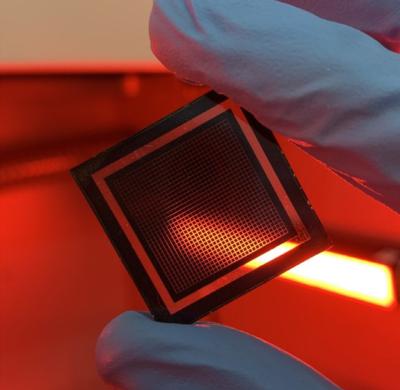Researchers from Pennsylvania State University have developed a narrowband (NB) imaging sensor combining R/G/B perovskite NB sensor array (mimicking the R/G/B photoreceptors in the eye) with a neuromorphic algorithm (mimicking the intermediate neural network of the human visual system) for high-fidelity panchromatic imaging.
A photo of a perovskite NB PD array made in this work. Image from study
Compared to commercial sensors, the team used perovskite “intrinsic” NB photodetectors to exempt the complex optical filter array. In addition, They used an asymmetric device configuration to collect photocurrent without external bias, enabling a power-free photodetection feature. These results presented a promising design for efficient and intelligent panchromatic imaging.
The retina is the essential part of the human visual system that receives light, converts it to neural signal, and transmits to brain for visual recognition. The red, green, and blue (R/G/B) cone retina cells are natural narrowband photodetectors (PDs) sensitive to R/G/B lights. Connecting with these cone cells, a multilayer neuro-network in the retina provides neuromorphic preprocessing before transmitting to brain. The research team in this recent study drew inspiration from this design, to build narrowband perovskite sensor array for panchromatic imaging.
The researchers demonstrated their R/G/B narrowband photodetector array using engineered halide perovskite films fabricated from a volatile solution (VS) system, followed by a multilayer algorithm to mimic human retina system for panchromatic imaging. The team's results demonstrated the photoelectrical capturing and restoration of a 1024-pixel full-color image by a 32 × 32 perovskite NB PD sensor array with three R/G/B channels. The signals were further processed using a neuromorphic network algorithm to mimic the plexiform structure in the intermediate cellular layer in retina. The results of the perovskite array display a high fidelity for panchromatic imaging. This system-level demonstration of the retina imaging process provides substantial insight for implementing panchromatic imaging techniques.
According to the study, the team demonstrated several fundamental breakthroughs in realizing perovskite NB PD chips for panchromatic imaging, from material synthesis to device design to system innovation. Briefly, they successfully obtained the highly uniform R/G/B perovskite thin films (<2 μm) with heavily unbalanced electron-hole mobility (μh/μe ~ 5) based on a volatile solvent method. By inserting these films into a p-i-n architecture, the unbalanced electron-hole transport and the WDOFD effect synergistically led to an NB detection with excellent performance in bandwidth, response speed, and optical linearity. Taking advantage of the good film uniformity, the researchers devised R/G/B image sensing chips using laser-scribing techniques and collected R/G/B photocurrent signals independently. Inspired by the retinal system, they combined the R/G/B perovskite NB chips (mimicking the R/G/B cone cells) with a trilayer algorithm (mimicking the intermediate network of the retinal system) and successfully realized panchromatic imaging. It is also worth noting that these perovskite NB PDs constructed in the asymmetric p-i-n configuration can have NB detection under zero external bias. This light-driven panchromatic imaging may trigger further development in applications such as battery-free cameras, light-driven sensing, artificial retina replaceable for dead retina cells in vision damages, etc.




